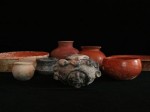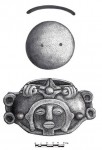Archaeologists excavating the ancient Maya site of K’o in northeast Guatemala have found the earliest known burial of Maya royalty. It was an unexpected find. The dwelling above the burial was owned by a wealthy individual, but it wasn’t a palace. It was the grave goods that indicated the skeleton buried among them was a member of the ruling elite.
 There were seven ceramic vessels in the grave, including jars, bowls, and one black incense burner depicting a figure wearing a headdress known by archaeologists as the Maya jester god. The jester god headdress is one of the earliest symbols of Maya royalty. It has previously been found on murals, carvings and pottery going back to 100 B.C.
There were seven ceramic vessels in the grave, including jars, bowls, and one black incense burner depicting a figure wearing a headdress known by archaeologists as the Maya jester god. The jester god headdress is one of the earliest symbols of Maya royalty. It has previously been found on murals, carvings and pottery going back to 100 B.C.
 Mesoamerican historians have dubbed the figure the jester god because his headdress bears a three-leafed design with the stems spread out like a jester’s cap with those little bells on the end. It’s a representation of an ear of corn, possibly a carry-over from an Olmec corn deity the Maya adopted as a patron god of royalty.
Mesoamerican historians have dubbed the figure the jester god because his headdress bears a three-leafed design with the stems spread out like a jester’s cap with those little bells on the end. It’s a representation of an ear of corn, possibly a carry-over from an Olmec corn deity the Maya adopted as a patron god of royalty.
The pottery and a bone from the skeleton have been dated to 350 B.C. There are earlier Maya burials, but none of them include a symbol of royalty among the grave goods, and this is by far the new record for the oldest representation of the jester god ever found.
“This is rare, this is old. We don’t find this every day,” says archaeologist Andrew Kinkella of Moorpark (Calif.) College, who was not part of the research. Jester god images were inevitably connected with inherited political power among the ancient Maya, he says. “So, I think we could safely say this is one of the oldest burials known of a Maya ruler.”
But what really matters about the find, Tomasic says, is that it shows the ancient Maya ideas about rulers were in place long before Maya kings declared themselves divine. That trend emerged in the later “Classic” period that saw the full flowering of ancient Maya writing and pyramid building. The so-called “Pre-Classic” era of the ancient Maya featured some of the same gods and notions of leadership that their descendants held until the time of the famed Maya collapse.
This link established between the very early Pre-Classic era and the late Maya civilization suggests that the Maya ruled for even longer than we realized. The archaeological team plans to excavate more homes in K’o and the larger site of Holmul. They hope to find more early royal burials, perhaps even earlier ones than this, that will give us more information about the way Pre-Classic Maya culture evolved and the strength of its ties to the pyramid-builders that followed.
Ok, I’ll give it points for the bones, but this joint is seriously lacking in Fabulous Tomb Apparel.
:skull:
Hmph. Forgot to add the name back.